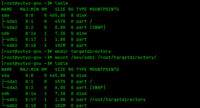Mount (Unix)

Mounting in Unix is like attaching a Lego block to another Lego block. When we want to use a new Lego piece, we need to attach it to the existing structure. Similarly, when we want to access a new storage device in Unix, we need to "mount" it to the existing file system.
Think of your computer as a Lego castle. But there's only so much space to build on top of this Lego castle, so when we need extra space to put our toys, we add another Lego board at the bottom. This is like adding a new storage device to our Unix system. But the problem is that the computer only knows how to talk to the existing Lego board at the top of the castle. It does not know there is a new Lego board at the bottom. So we need to take the new Lego board and snap it to the top, in its own special place, and then the computer will recognize it as a separate space.
That's what mounting does in Unix. It takes a new storage device, such as a USB stick, and attaches it to the existing file system in a special designated spot, called a mount point. The mount point is like a label on the top Lego board, telling the computer where the bottom Lego board is attached. Once the storage device is mounted, we can access it just like any other directory in our file system. It's like having a secret room under your bed that only you know about.
So, in a nutshell, mounting is like connecting a new storage device to our Unix file system by linking it to a special designated spot, or mount point. This allows us to access files stored in the device just like any other file in our file system.
Think of your computer as a Lego castle. But there's only so much space to build on top of this Lego castle, so when we need extra space to put our toys, we add another Lego board at the bottom. This is like adding a new storage device to our Unix system. But the problem is that the computer only knows how to talk to the existing Lego board at the top of the castle. It does not know there is a new Lego board at the bottom. So we need to take the new Lego board and snap it to the top, in its own special place, and then the computer will recognize it as a separate space.
That's what mounting does in Unix. It takes a new storage device, such as a USB stick, and attaches it to the existing file system in a special designated spot, called a mount point. The mount point is like a label on the top Lego board, telling the computer where the bottom Lego board is attached. Once the storage device is mounted, we can access it just like any other directory in our file system. It's like having a secret room under your bed that only you know about.
So, in a nutshell, mounting is like connecting a new storage device to our Unix file system by linking it to a special designated spot, or mount point. This allows us to access files stored in the device just like any other file in our file system.
Related topics others have asked about:
